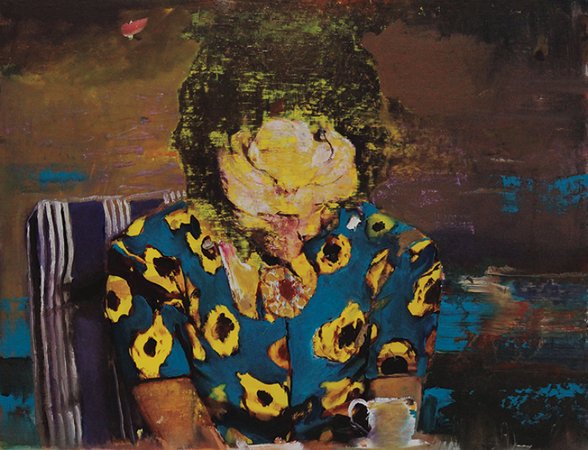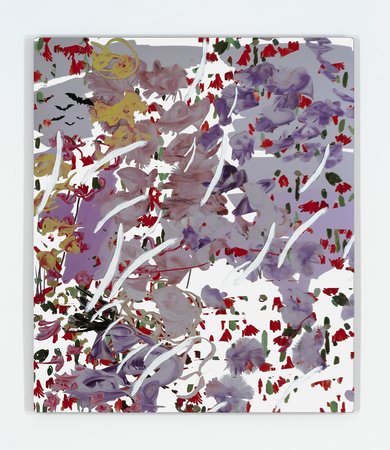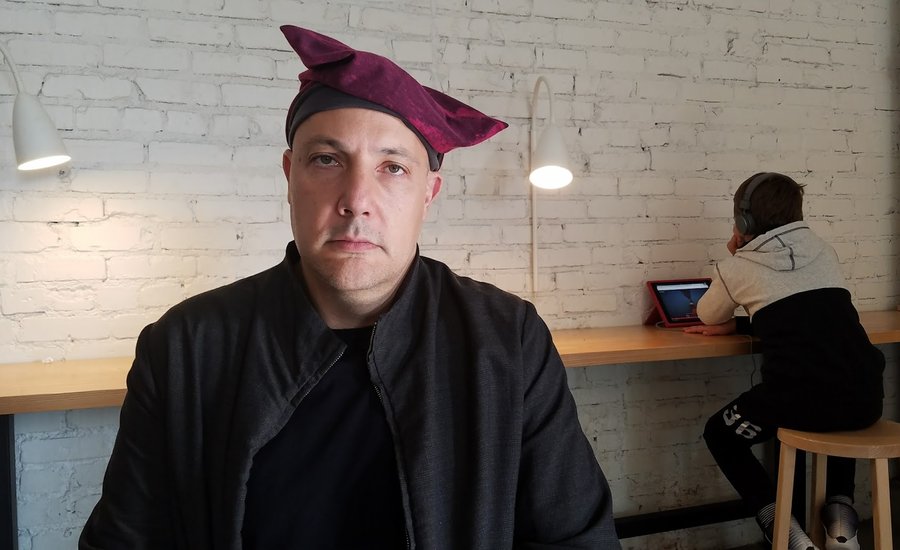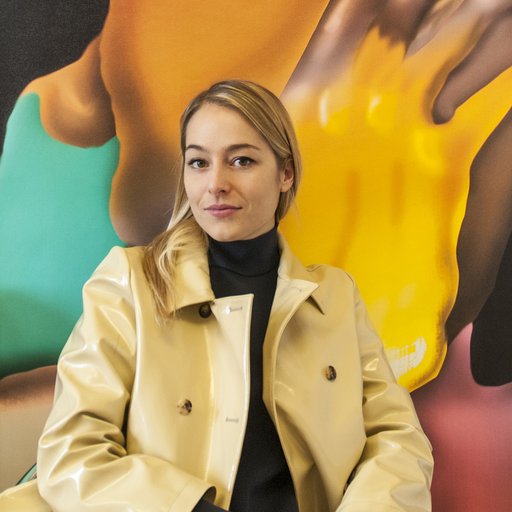As the art industry undergoes its messy transition into the globalized digital era, a handful of self-styled change agents have emerged with visions of how to best leverage and guide this period of upheaval. None of them have been as polarizing as the art collector, consultant, and entrepreneurStefan Simchowitz.
A Los Angeles native with roots in both the movie biz (he helped produce Requiem for a DreamandThe House of Yes) and the start-up world (he co-founded the photo-distribution site MediaVast, which was acquired by Getty Images), Simchowitz emerged as an enthusiastic flipper and viral market-maker during the last art boom, becoming known for his bracingly Darwinian, accelerationist perspective in a field traditionally known for caution, deliberation, and slow connoisseurship. The New York Times labeled him “the art world’s patron satan,” a catchy sobriquet that has stuck; Jerry Saltz called him a “Sith Lord from the Brotherhood of Darkness,” and an avatar of “the New Cynicism.”
Unsurprisingly, given the irresistible appeal of extremity, Simchowitz has also earned many fans—among them hot-money collectors, dealers on the make (like Johann König), hungry-eyed artist ingenues, and professional gamblers—as well as the watchful attentions of industry leaders with their fingers to the wind. (Art Basel director Marc Spiegler warned that “gallerists disregard Stefan at their peril.”)
Today, Simchowitz and his boutique team advise artists and clients alike on how to benefit from the market’s turbulence, advocating their services through his website Simco’s Club and his influential feeds on Instagram and Facebook. Many reputable galleries refuse to do business with him, fearing he poses a risk to their artists’ markets—the opposite of the legacy collections and institutions where they hope to place work. He, in turn, largely sees these galleries—and their overarching system—as corrupt, hidebound, inefficient, and philosophically juvenile.
So, who better to talk to about the state of the art gallery? Ask a fox their perspective on a fenced-in chicken coop and you may not get the most objective answer, but you will get some strongly held views. Here, Artspace editor-in-chief Andrew M. Goldstein spoke to the controversial, highly intelligent insurgent about where he sees the art market going, and the opportunities to be found in the present reckoning for art galleries.
There are a lot of galleries that are having a tough time at the moment, and the reasons are well known: The art market—together with the overall luxury market—has slowed; the cost of doing business has gone up due to fairs, rising rents, and a relentless drive to expand and keep artists; and blue-chip galleries are proving very tough competition. Why are the galleries having such a tough time?
The blue-chip galleries are really monopolistic formations of culture, and they’re essentially interested in the tuna-belly sushi of the art world, which is the estates of dead white male artists that generate the bulk of their revenue. Compared to them, everyone else in the system is just set decoration, and it’s within this structure that mid-size and small galleries are enticed to do these fancy fairs and hire a fancy curator and take on other costs. They are almost like cannon fodder in a war, you know—the foot soldiers you send out to exhaust the troops on the other side. These galleries are literally the cannon fodder of the culture industry. Then, after everyone has had a nice experience walking around the smaller galleries in a daze of pseudo-discovery, the big galleries have the prize spaces that people can tumble into and spend some real money.
The cannon fodder? They can maybe last two to six years. They opt into this programmatic system of value where they say, “Oh, this young artist was just bought by an institution!” It’s crazy. I have had countless conversations with collectors about 27-year-old artists where they ask, “What institutional shows are they doing, which institutions are collecting them?” I’m like, “The guy is 27 years old! He doesn’t need to be collected by institutions for a decade.”
But there’s this ridiculous cycle that has fetishized the power of quasi-institutional curatorial elite, and these guys are so intellectually corrupt and corroded by the vapor climbing up their assholes that they have essentially lost their compass of what is actually the art that is interesting in our times. Just look at Contemporary Art Daily, which is really useful as far as it aggregates what gallery curators find interesting at that time, and it’s completely and utterly predictable—there’s never anything you see that is not predictable. It’s like a conformed architecture of culture that gets distributed.
What would you say is the important service that a gallery provides?
The gallery does business off its artists, so it keeps food on the their table, it keeps the machine running for the artist’s studio, it communicates with collectors and curators as an intermediary for the work, it puts together a CV, and it publishes books if it can. A good gallery does this, and there are many good galleries. I just bought a bunch of artwork from Mihai Nicodim, who is a gallerist in L.A from Romania who brought Adrian Ghenie to America. His was the first gallery to represent Ghenie with Plan B, and he was a guy who sold a lot of Oscar Murillo to me. He is completely easy and unpretentious to deal with.
 Adrian Ghenie
Adrian Ghenie
Unfortunately, most galleries conform to a set of exclusionary ideals and principals that have failed the artist and the system at large. And there are functions that a basic gallery does properly, but those functions can be replaced by different entities—they can be sourced out. Certain things can be done internally in the artist’s studio, like book publishing and CV-building, for instance.
Let’s establish the functions of galleries that are beneficial. You mentioned supporting artists, building their CVs, and being an intermediary to collectors. By definition, they also have a space to put on shows, no?
They provide an exhibition solution, which is critical. They provide other absolutely critical functions too, but they do it in a way that is inefficient. They don’t realize that they are over-invested in physical space, over-invested in art fairs, under-invested in book production, under-invested in purchasing works from the artists upfront. They are like trained monkeys, behaving in certain ways. Only those galleries that ignore the noise are able to build sustainable businesses. A gallery that is out of business is a gallery that cannot provide the functions that are required for an artist to stay in business.
So, yes, there is a checklist of things that galleries do and that are good. But the crisis really exists within the mid-level and small gallery system, which is essentially having its lunch eaten by the big gallery system, and by status-obsessed artists who are taking advantage of their mobility. Look at how Rachel Uffner just lost Sam Moyer. Over six years, Uffner built Moyer from nothing into what she is today, and then Sam Moyer leaves to go to a bigger gallery just as Uffner moves into a bigger space, leaving her holding the bag.
The relationship between gallery and artist is complicated—but then again, Uffner is closed-minded and impossible to deal with for someone like me. After my experience of trying to buy Hilary Harnischfeger’s work from her a decade ago I would never even consider giving her a call, because it would be a waste of fucking time, so why bother? They have set up the situation where, on the one hand, the artist is the soul of the gallery, but, on the other hand, where the artist can leave. Because there is no way Uffner can build a business that’s sustainable with the way that she operates. They have this idea of how a buyer is supposed to behave, so they alienate collectors with this system that is quite contentious across the board, and that leaves the gallery in crisis.
The question is, how do you mediate a new form of relationship with the artist? It’s difficult, because artists are convinced of what they should want by their peer group. If you look at Joe Bradley, Bradley was made by Canada Gallery, and then Gavin Brown swooped in when Joe Bradley was literally just taking off. Joe Bradley would have taken off with or without Gavin—the plane had already left the runway, but Gavin just came in and took all the credit. So, the perception of where the credit lies is oftentimes completely misdirected by opportunistic, bigger-sized galleries who nab the bird just as it’s launching into mid-air, like with Eva Presenhuber and Sam Falls. Subsequently, what happens is that the market weakens and doesn’t pan out like it should.
What’s fascinating is that there’s a contradiction embedded at the heart of this, which is that lower and mid-range galleries have beautiful spaces, they provide a great context for exhibitions, they nurture up-and-coming younger artists—often right out of graduate school—and they create an exciting context that the art world can enjoy, entirely for free. But then, when the artists start to make real money, they bring those gains with them if they leave for a bigger gallery. In that way, the smaller, incubator-style galleries are almost a for-profit business trapped in a non-profit body.
One hundred percent. My system is different. I believe that the quality of the production of art coming out of the studio is central to the sustainability of the practice, and that sustainability is a function of having stable working capital financing the artists within their studio practice so it can develop and grow, unimpeded by the stress of essentially exogenous factors like not getting paid by a gallery, dealing with shipping, and dealing with multiple galleries—half of whom don’t pay you. You need to centralize and rebuild this relationship between artist as producer and gallerist as distributor.
My solution is you put yourself in the middle as a sort of wholesaler financier to manage and mediate this complex set of relationships where you have leverage over the artist, so the artist can’t behave like Bolivia, a country where you invest a billion dollars in building a refinery and the minute you finish the Bolivian government confiscates it from you and privatizes it. That, effectively, is what happens when someone like Sam Moyer leaves someone like Rachel Uffner. Uffner built the refinery over six years, and then Moyer is the Bolivian government privatizing her cultural production—that’s how I see it.
It’s not enough to just change the gallery—you have to change the whole system. So instead of the entire fine-art world looking like Contemporary Art Daily—this kind of supposedly diverse, homogenized collection of artists who are distributed by these fancy galleries and institutions—you have to change the way you look at art, how you think of art, how you measure the cannon, how you re-measure the cannon. You have to re-calibrate the entire system. And the system is now in the process of being recalibrated, because gravity is a force that no one can resist. It is the ultimate purveyor of truth, and all of these ideas and ideals are basically coming back to earth, effectively.
From a fundamental standpoint, do you think it is easier to sell something if you have a gallery or if you don’t have a gallery?
It’s easier to sell something if people want it, and if it’s good. Big galleries pretend to sell works, but 50 percent of the artists, at Hauser & Wirth, Zwirner, Gagosian, blah, blah, blah, probably do under half a million in gross sales a year. Everyone thinks there is this massive business, but there isn’t. It’s all an illusion—just watch Adam Curtis’s HyperNormalisation. Until we get rid of that illusion, we are not going to be able to build an authentic, healthy, sustainable system that actually supports artists of diversity producing art all over the world. You have to have some equality.
You want to talk about art, look at Mark Grotjahn making $50 to $70 million a year, selling paintings directly out of the studio for $10 million. Look at Mark Bradford making $20 to $25 million a year. These are no longer situations of the artist as a suffering individual. Artists are the ultimate beneficiaries of successful industry strategies in a way that is akin to movie stars in the 1980s. We have to come up with a much more realistic relationship with artists than this. Some people come up to me and brag, “I love artists, I love art—it is just about the art for me,” as if I am some evil character who hates art and artists. But the current system is completely obscene in its impracticality.
What is amazing about this environment where everything has fallen apart is that I would have thought the galleries would have said, “Ahh, I see the light! We are going to change, we are going to open up.” They haven’t. They have dug in their heals. We have to break the system. We have to open it up. I systematically try to do this—successfully, I might add.
You sell art, you work with artists, you advise clients. Are you a dealer? Are you a gallerist?
I am everything and nothing.
Can you elaborate?
The key is to be a Swiss Army knife. As Bruce Lee says, “You must be shapeless, formless, like water. When you pour water in a cup, it becomes the cup. When you pour water in a bottle, it becomes the bottle. Be like water my friend.” You have to adapt. You have to be what you need to be in order to get things done. Every great dealer, every great gallerist in history has been a greater collector than most of their collectors. Every great dealer, historically, has been a great collector—Yvon Lambert, Heinz Berggruen, Ernst Beyeler—because every great dealer ultimately wants to collect the artwork themselves. With dealers who do not collect in depth, there is no way they can be aligned with the interests of their artists.
Let’s look at the way you are operating, because one thing that happens when you dematerialize the art from its traditional gallery/dealer context and start using alternative channels and strategies to sell it is that things speed up like crazy. They have a saying in traffic school: speed kills. Does that apply here?
Speed kills? We’re not talking about a car. I’ve got news for you, speed doesn’t kill Usain Bolt. I had an artist last week say, “Oh, it’s going too fast, I have to be careful. I’m going to show in shitty galleries, because I’m scared of what’s happening.” If I sat in a bar with Pablo Picasso in 1920, do you think he would say, “Oh, I’m going to be careful and not promote my ideas because I’m moving too fast as an artist”? No, he is Pablo Picasso, and neither would de Kooning, or Koons, or van Gogh. They don’t think about these things—they produce. They don’t think, “Oh, well, speed’s going to kill my career.” It has nothing to do with that. Do you tell Usain Bolt not to try and break the world record, because if he does he might never be able to do it again? No, you go for it!
But we just went through this Zombie Formalism period, and a lot of those abstract painters who churned out tons of canvases to meet frenzied demand have now seen their markets disintegrate, and their reputations sink. It all happened very quickly, and ended in twisted wreckage.
Because they were greedy and they were stupid. A car whose tires are not properly screwed is bound to crash if it goes fast, but if the car is well-built it can withstand speed. They were greedy, and I dealt with most of them. I talked to them and they were like, “I consulted 10 different people and they said I overproduced!” It is not that the speed killed them, they killed themselves. Their greed and stupidity killed them. There is this idea that artists were taken advantage of and moved too fast, but they couldn’t resist the opportunity to make money.
Every single artist who collapsed—Parker Ito, Michael Manning, all of them—I watched them first-hand alienate their initial collectors, not listen to advice, overproduce, and let their galleries get greedy and think they have 10 times more collectors than they actually did. I watched it happen. I would buy 10 works and then call the gallery and say, “Don’t sell these ones—don’t sell so much!” They said, “Oh, we don’t need you anymore, because we can’t let everyone know that you bought 10 works and then not let 50 people other people also buy 10 works.” It has nothing to do with speed, it’s got everything to do with greed and stupidity. You don’t say a fast-moving vehicle crashes because it moves fast. It crashes because it crashes.
What if the vehicle was not supposed to go that fast? Sometimes you might have a Ferrari, and sometimes you might have a Pinto. What if there’s someone in the back seat of the Pinto yelling, “Faster, faster, faster!” and the driver doesn’t know any better and then the car explodes? That seems to be what happened a lot with those artists. And it was pretty clear from the outset that none of them were Picassos or van Goghs.
No, they weren’t. Most of these guys weren’t meant to be going that fast, but it wasn’t some evil character making them go that fast. It was themselves. It was their own greed, their own stupidity, their own short-sightedness, their own arrogance. It’s that same kind of short-sightedness that damages everything. Sometimes you need to move fast, sometimes you need to move slowly, and the key is to have someone who can help regulate that. When you don’t you’re in trouble. The artist I manage, Petra Cortright, is doing very well today. She is one of the few people from that era who is not a casualty of the market, and this is evident to every single person who watches the market. Do you think that is arbitrary? Petra Cortright, the only one I manage out of that whole Post-Internet generation, was loyal to me and stuck with me through thick and thin. She is doing fine.
 Petra Cortright
Petra Cortright
She is versatile and talented.
She is versatile and talented, but she has also been well-managed.
But, to return to the idea of speed, you have been accused of all kinds of monstrosities, but the worst thing you have actually been accused of specifically and repeatedly is artificially increasing an artist’s inventory by presenting components of larger artworks as standalone pieces. There are reports that you did this with Ibrahim Mahama, when you sold 300 small parts of an enormous jute-sack installation as individual “paintings,” and also with Amalia Ullman, who said you cut up a large work and sold it in the same piecemeal way. That does speed up an artist’s production by bringing many extra works into the market.
First of all, that story about Ibrahim Mahama is bullshit. Number one, it was proven to be incorrect. His gallerist in Italy, I believe, basically changed the way Ibrahim thought of me. It is a false story. And with Amalia Ullman, I didn’t cut it up and try to speed it up—it’s a false narrative created by the New York Times, which mischaracterized my relationship with Amalia. It was a completely false negative narrative constructed by the media to create a negative story, and it did me damage. It was incorrect. I cannot defend something that is technically false. It is incorrect. This speed thing is the equivalent to, “Jews eat Christian babies—be careful of Jews.”It is absurd.
Who are some artists you work with, besides from Petra?
Kour Pour, Zachary Armstrong, Serge Attukwei Clottey.
How do you work with them, exactly?
I work with them as an intermediary, making sure I buy a lot of material so that through ownership of their work my interests are aligned with them. I make sure that they receive the right advice about what to do. I don’t have a contractual relationship with them, but I am invested in their careers’ success and in their making the right decisions—and that is singularly a function of me owning their material, simple!
That is why dealers who own the material of their artists are unilaterally aligned with the artists they work with. It’s a very simple thing: all you need to do is own the art and the rest takes care of itself. And, to the best of my ability, I form a deep relationship with any artist that I own in depth. Some relationships are deep, others not so deep—some don’t need me as much. Others have decent gallery systems and have their own mechanisms in place that they have developed, or that I have helped them develop. Then they go on to prosper on their own. It’s a simple relationship.
So you are more like a tech start-up incubator, where you invest in the beginning and buy up a piece of the company at low cost.
Of course it’s in the beginning. But you invest in the beginning, you invest in the middle, and you invest in the end. You hopefully continue. You are a shareholder, a stakeholder in their cultural production, and you hope to attract other stakeholders in their cultural production because you need many stakeholders and partners to make it successful. So it is a very different role. A gallery is not a stakeholder but a bouncer at a nightclub to ensure they are letting in the right people. My job is to find stakeholders who can really help the artists long-term at varying degrees. Small stakeholders, large stakeholders—every collector I engage with becomes a stakeholder in the process. They must be communicative, they must understand strategy, they must understand whether I overcharge them for work or undercharge them for work. There is some element of partnership. There is never a formal agreement with the artists. It’s a very simple relationship.
 Zachary Armstrong
Zachary Armstrong
Who would you not sell to?
I wouldn’t sell to anyone who I believe would do things that are harmful to the long-term best interests of my artists. But it has nothing to do with like, “Oh, the guy is going to flip it at auction tomorrow.” You need to be tactical and strategic.
Who is an example of somebody you see as harmful to the best interests of one of your artists?
A client of mine, Abdullah Al Turki, sold a Petra Cortright at auction that I sold to him for $22,000. He’s a fancy collector, he goes to all the dinners, blah, blah, blah. I probably wouldn’t sell to him again, but not because he sold at auction. If he had said he was planning on selling it in a year, I probably would have been… well, I just don’t like the bullshit. A lot of the fancy collectors, to be honest with you, I have no interest in. I have no interest in selling Petra Cortright’s work to the Horts. I couldn’t care less. I don’t care. My metrics are totally, totally different then those of the traditional system, because I value people within the system very differently.
The gallery system is like, “Oh, Stefan Simchowitz is a terrible person, be careful of him!” Be careful of what? Orlando Bloom, Katy Perry, Nicolas Berggruen, who I was just with? Be careful of someone who has the best access in the world? A lot of these positions are profoundly incorrect because they are made by small-minded people with small visions and views of the world, and they don’t understand the big picture. I do a lot of business with different categories, so my decision-making about selling is very different. I have a profoundly different view of it.
How do you make sure that the artists you work with have opportunities to exhibit?
All of the artists that I work closely with don’t have masters degrees—they’re part of their own thing. They’re almost outsider artists who found themselves within the fine-art system. I get them galleries.
They all have galleries. Petra is with Société in Berlin, Foxy Production in New York, Ever Gold in San Fransisco, Carl Kostyál in London—she has a huge gallery network. Zachary Armstrong is represented by Jack Tilton and Joel Mesler. Kour Pour is represented by Marta Gnyp. Serge Attukwei is represented by Gallery 1957. They all have galleries.
How do you work as an intermediary between the galleries and the artists?
I just make sure of what gets sold. I help set the pricing, I help make sure there’s not too much inventory, I help make sure galleries aren’t competing against one another. I make sure that five galleries don’t have 60 works on the market at the same time. I make sure that if one gallery has a show the other gallery doesn’t have the same inventory so that it’s fair and everyone has a clean runway. I make sure there are not overlapping piles of inventory. I make sure that the gallery is not stupid enough to try to sell something an artist makes that is not sellable but to just use it like set decoration. In most galleries a guy can put a piece of toilet paper on the floor and they will try and sell it. That just creates an abundance of inventory.
What about something like the nonprofit Depart Foundation in Los Angeles, which has exhibited Kour Pour, Petra Cortright, and another artist who was in your circle, Grear Patterson, in the span of a few months. How does that arrangement work?
I help support the Depart Foundation, I also helped Cesar Garcia at the Mistake Room. I donate money to them, I donate art to them. I donated Cesar an Oscar Murillo work that he sold to raise money, and have helped Depart is a very similar way. It’s a great young foundation—it’s doing an Edward Curtis show next month, it’s doing an Ulay show, it’s building a great track record. Everyone talks about a conflict of interest with the Depart Foundation, and then I read a press release from the Swiss institute that says Lisa Schiff and Iwan Wirth have joined the board. Everyone points the finger at me, but I’m like, “Lisa Schiff joins the board of the Swiss Institute?” It’s a joke.
 Oscar Murillo
Oscar Murillo
But I support institutions. I give work to the Brooklyn Museum. I gave a sculpture to the Nasher last year. I’m on one of the boards of MOCA. I just joined the board of the Desert Biennial. It’s not like some conspiracy or anything. I support a lot of mechanisms because they are distribution outlets for artists, and they need institutions. I help get institutions, help with retail, finance book publishing—anything a good gallerist would do.
Do you get any kind of compensation?
No! I don’t get compensation—of course not.
So you benefit strictly through raising of the value of their work that you own in depth?
Yes. It is a very simple thing. I go to artists, ask how much a work is, and say, “I’ll buy it.” That is the complete extent of my contractual arrangement with anyone, ever. There is nothing ever more complex than that: “How much is it?” I buy it. Simple, like a 19th-century art dealer. They would go to Turner’s studio, say, “I like this painting, I like this painting, how much can I have them for?” Boom. Simple. Nothing else happens. Now I have 540 different artists in my collection, and close to 3,500 works. And I will do whatever I can to support the artists.
It’s interesting, because in some ways you seem to be acting as an agent for these artists, but in other ways not.
I don’t have a traditional agency relationship with any of the artists. There is nothing like, “Oh, I’m going to get you this deal and take a percentage,” There is no fee; there is no service. I buy the work, I support the artists, and hopefully I accrue value to the artists. You know Oscar Murillo? Early on I happened to buy 30 works, I didn’t spend a lot of money, and I have accrued a lot of value through that. I bought 20 big paintings, which probably cost me $60,000. That is now probably worth six to eight million dollars. This is totally in line with my doing whatever I can to support Oscar Murillo’s career.
I mention the agency model because you recently did a very interesting deal with ICM, one of Hollywood’s biggest talent agencies. Can you talk a bit about that partnership?
The ICM thing was an opportunity to create what I call Museum 2.0. They have a space of 120,000 square feet, they spent 10 million dollars on the renovation, they were moving to the penthouse, and eight months ago an old friend there called me up and said he needed advice on art for the space. I made it really simple. I said, “You pay for the installation, which is expensive, you publish a book, which is expensive, you pay for the storage, and we’ll make a deal. We’ll do a partnership, and we will rotate it every year. We will get everyone in ICM who doesn’t look at art to look at art, and we will get all of their clients to see the art.”
At ICM they end up getting 15,000 people a year who are visitors of note, and to get them to look at art is an amazing thing. I go to museums, but no one goes! With gallery shows, people go to the opening for 10 minutes when it’s crowded and they never see the art.
This art has lit up the agency. The guy walking around with a mail cart comes to me and says, “This is amazing—I’m seeing so much!” It’s an amazing thing. I tried to get the New York Times to cover it but they won’t cover it because it’s not open to the public, like that’s means anything. But, Katie Holmes gets to see it. Ellen DeGeneres, Usher, ICM’s other clients, their assistants, people in the mailroom, everyone gets to see it. These definitions of public and private are profoundly corroded in defining that one kind of group of people is better than another. We have to open up the definition so we can get the art out there for people to see. And the ICM install has encouraged a handful of new collectors in total engagement. Their are over 90 artists represented there, and 400 works. It is profoundly powerful.
Is this all work from your collection?
Yes, it is all my work. I think of it as taking the mountain to Mohammed and being like, “Guys, look! Look what you can buy.” And every day they’re going to walk in there and see what art can do to you. If you see the exhibition, it’s very formal, it’s hung in a museological way, it’s heavily curated, and after these people see it for 50 days in a row they’re going to think, “You know what? I need help with my office. Can you come over to my house and help me?”
It’s an extremely slow process, and one that needs to be done in a way that’s hands-on and bespoke—there’s no automation for it. And the accumulation of a huge amount of artworks allowed me to hang six paintings by this artist on one wall, 10 by this artist on another wall, five of this one. It basically let me curate solo exhibitions in the space, so people don’t just see one piece by an artist here and there in a mishmash, but can see a solo exhibit of Jon Rafman, a solo exhibit of Chris Hood, a solo exhibit of Charlie Billingham, a solo exhibit of Oscar Murillo. So they’re actually able to engage with the work in a way that is elongated, and has certain depth to it.
It’s interesting, because these big talent agencies like IMG and UTA have been getting involved with contemporary art lately, even starting to represent artists as clients.
Yeah, I know. They are trying to represent artists. They are trying to represent artists to get them a career-ending deal with a bag manufacturer. They are trying to represent artists to make a movie. There is nothing particularly interesting about it. But artists produce very specific kinds of things in a unique way.
Those kinds of deals also risk spreading an artist thin, distracting them from their studio.
So much of the system today is a game of strategy and positioning. The artists are spending more time on planes, going to art fairs, going to biennials, duh, duh, duh. They are spending more time flying around than they are building proper studio practices, and you see it in the work. You know, the best work of these artists is produced before they have success, because the minute they have success they’re on a plane flying all over the world, schmoozing with everyone. So the only work you would really want is the early work, when they are sitting in their studio, slaving away, and focused on the production. Many successful artists feel they don’t have any time to do anything.
How do you make sure that the artists you are working with don’t take on that jet-setting lifestyle?
You slow it down, and you speed it up. You speed it up by providing the working capital for the studio, and you slow it down by limiting the amount of distractions they have. Ironically, you do it by making sure they are not over-engaged—that they are not engaged to a degree where their practice will suffer. When an artist has money in the bank and they are not stressed about sending work to a fair that they may or may not be paid for then their whole rhythm changes.
Most artists don’t have someone like me. Most of them have to rely on selling their work to a gallery or a dealer, so they get a fancy dealer like Balice Hertlingand they send a work there and they end upsuffering to get paid. That period, from the inception of an artwork to production to the delivery of the money, can be two years, or never. It’s out of pocket, but they were with a fancy dealer who had fancy relationships with fancy curators. At the end of the day, there is no money there. Production slows down, and they have to move to a different studio. They cannot afford the to make a video or do something, and the factory suffers.
The factory is the most important thing for an artist. The studio is the factory, and if the studio is not stable, then nothing good can happen. If a car manufacturer, essentially, has a factory that is not stable, then the wheels fall of the car. That is the central premise. It is a very basic, basic premise. You buy the work, you own the work, you are invested without a formal contractual obligation to any artist. By nature of good will, and by basically having your interests mutually aligned, you support and market an artist.
We began by discussing the white-cube gallery model, which became so successful because it is so easily replicable. They’re more or less the same anywhere you go in the world—a minimal, white-walled, often industrially designed space where you can sparingly hang artworks at just the right height. Is what you’re doing replicable, or is it a total anomaly?
It’s a total anomaly. Because every individual has a different set of skills and a different set of relationships. So this idea of a perfectly replicable, automated system is a pipe dream, because none of the formulas work. I just watched Adam Curtis’s new documentary HyperNormalization, and he discusses how everyone has this need to find order, so what politicians do is find some sort of order that they can provide to the masses. There is no fucking order in the world we live in today.
The point is, you’ve got to find your own line down the mountain to ski, and you’ve got to stick to that line. The minute you listen to other people you have failed. But, while what I do is not replicable, there are ideas that I promulgate that people can adopt and hopefully say, “You know, I don’t have to be so fearful of being an outsider or of being criticized or of being excluded.” With the politics of exclusion, once you acknowledge the fact that you’re not really being excluded, you’re being feared—once you can psychologically prepare yourself for that—you can actually provide things to artists and clients in a way that is differentiated and in their best long-term interests.
But I can’t give you an outline of a contract you can use, because everything is variable, and the search for order in this world is over, because no one is in charge. We live in a non-linear, nonhierarchical environment where hierarchies appear and then disappear, and the key is building systems to respond to that creatively and in an efficient way.
I’ve been fortunate to attract some very significant clients and engage with them in ambitious projects, like Nicolas Berggruen, who is building this massive foundation behind the Getty that has Herzog & de Meuron as the master planner and a Tadao Ando side building. That has been a fantastic project to work on closely with Nicolas and document. I have the privilege of having people who watch what I do and are attracted to my vision, and it’s very exciting to service them. At the end of the day, I’m a service provider for my clients.
[related-works-module]























